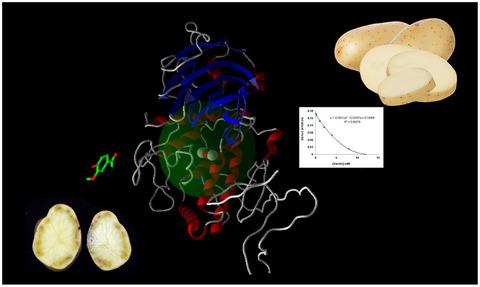当前位置:
X-MOL 学术
›
J. Food Biochem.
›
论文详情
Our official English website, www.x-mol.net, welcomes your
feedback! (Note: you will need to create a separate account there.)
Toward more specific inhibitor for Solanum tuberosum polyphenol oxidase through a structural insight into its activities and inhibition
Journal of Food Biochemistry ( IF 3.5 ) Pub Date : 2021-09-24 , DOI: 10.1111/jfbc.13949 Narges Ghorbanian 1 , Amir Mousavi 1 , Mohammad Javad Marefatjoo 1 , Narges Soltani Ghofrani 1 , Tahmineh Lohrasebi 1 , Kamahldin Haghbeen 1
Journal of Food Biochemistry ( IF 3.5 ) Pub Date : 2021-09-24 , DOI: 10.1111/jfbc.13949 Narges Ghorbanian 1 , Amir Mousavi 1 , Mohammad Javad Marefatjoo 1 , Narges Soltani Ghofrani 1 , Tahmineh Lohrasebi 1 , Kamahldin Haghbeen 1
Affiliation

|
To prevent enzymatic browning, applying a polyphenol oxidase (PPO) inhibitor is more desirable, especially when the freshness of the product matters. Most of the inhibition studies were done on mushroom tyrosinase (MT) while the literature indicates that MT and PPO of Solanum tuberosum (PPOsol) respond differently to the same modulator despite their similar active sites. This research was conducted to deepen our knowledge about PPOsol and introduce a more specific inhibitor for this enzyme to be used in controlling the enzymatic browning of potatoes. A modified procedure was developed for PPOsol purification. The enzyme was subjected to some essential physicochemical and kinetics studies. In parallel to the comparable physicochemical properties, homology modeling revealed high structural similarity between Solanum lycopersicum PPO (PPOsly) and PPOsol except for their active site pockets. Accordingly, PPOsol showed 5.1- and 34-fold higher affinity toward chlorogenic acid compared with two PPOsly isozymes. Alike PPOsly, PPOsol showed monophenolase activity but it was inactive toward L-tyrosine and p-coumaric acid. Based on structural criteria, phthalic acid, cinnamic acid, ferulic acid, and vanillin were selected and thoroughly examined for inhibition of the catecholase activity of PPOsol. Although all these substances inhibited PPOsol in mixed-inhibition mode, the results were strongly in favor of vanillin with IC50 < 1.37 mM and Ki < 1.2 mM.
中文翻译:

通过对马铃薯多酚氧化酶活性和抑制的结构洞察,开发更特异的马铃薯多酚氧化酶抑制剂
为了防止酶促褐变,更需要使用多酚氧化酶 (PPO) 抑制剂,尤其是当产品的新鲜度很重要时。大多数抑制研究是对蘑菇酪氨酸酶 (MT) 进行的,而文献表明马铃薯的MT 和 PPO (PPO sol ) 对同一调节剂的反应不同,尽管它们的活性位点相似。进行这项研究是为了加深我们对 PPO溶胶的了解,并为这种酶引入一种更具体的抑制剂,用于控制马铃薯的酶促褐变。为 PPO溶胶开发了一种改进的程序纯化。对该酶进行了一些必要的物理化学和动力学研究。与可比较的物理化学性质平行,同源性建模揭示了番茄PPO (PPO sly ) 和 PPO溶胶之间的高度结构相似性,除了它们的活性位点口袋。因此,与两种 PPO sly同工酶相比,PPO溶胶对绿原酸的亲和力高 5.1 倍和 34 倍。类似 PPO sly , PPO溶胶显示出单酚酶活性,但对 L-酪氨酸和对香豆酸无活性。根据结构标准,选择了邻苯二甲酸、肉桂酸、阿魏酸和香草醛,并彻底检查了对 PPO溶胶儿茶酚酶活性的抑制作用。尽管所有这些物质都以混合抑制模式抑制 PPO溶胶,但结果强烈支持香草醛,IC 50 < 1.37 mM 和K i < 1.2 mM。
更新日期:2021-11-07
中文翻译:

通过对马铃薯多酚氧化酶活性和抑制的结构洞察,开发更特异的马铃薯多酚氧化酶抑制剂
为了防止酶促褐变,更需要使用多酚氧化酶 (PPO) 抑制剂,尤其是当产品的新鲜度很重要时。大多数抑制研究是对蘑菇酪氨酸酶 (MT) 进行的,而文献表明马铃薯的MT 和 PPO (PPO sol ) 对同一调节剂的反应不同,尽管它们的活性位点相似。进行这项研究是为了加深我们对 PPO溶胶的了解,并为这种酶引入一种更具体的抑制剂,用于控制马铃薯的酶促褐变。为 PPO溶胶开发了一种改进的程序纯化。对该酶进行了一些必要的物理化学和动力学研究。与可比较的物理化学性质平行,同源性建模揭示了番茄PPO (PPO sly ) 和 PPO溶胶之间的高度结构相似性,除了它们的活性位点口袋。因此,与两种 PPO sly同工酶相比,PPO溶胶对绿原酸的亲和力高 5.1 倍和 34 倍。类似 PPO sly , PPO溶胶显示出单酚酶活性,但对 L-酪氨酸和对香豆酸无活性。根据结构标准,选择了邻苯二甲酸、肉桂酸、阿魏酸和香草醛,并彻底检查了对 PPO溶胶儿茶酚酶活性的抑制作用。尽管所有这些物质都以混合抑制模式抑制 PPO溶胶,但结果强烈支持香草醛,IC 50 < 1.37 mM 和K i < 1.2 mM。











































 京公网安备 11010802027423号
京公网安备 11010802027423号